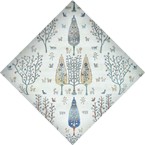Balochi or Baluch Rugs are traditional tribal rugs that are made in the wider area of Baluchistan on the eastern borders of Iran and western Pakistan and southern Afghanistan. Balochi rugs often present geometric motifs and tribal designs, and because initially they were made for the use in nomadic tribes inside the tribal tents, they were often weaved in smaller sizes. Balochi rugs can make very fine entrance rugs or can be used in smaller spaces; they would fit very nicely in a traditional or minimalistic settings.
What are Baluch rugs?
Baluchi rugs are hand-knotted area rugs weaved by tribal people who live in an area called Baluchistan. So in the international market rugs created by these folks are named Baluchi rugs. Other spelling variations also exist such as; Baluch, Balochi or Baluchi. Baluchi rugs share similar characteristics that make them distinct from other rugs. They differ from other rugs due to their design, pattern, motif and color. Baluch rugs come in smaller sizes and use a different type of dye. Common sizes include 3 x 5, 4 x 6, and 5 x 7. The most common rug shape in Baluchi rugs is rectangular. In rare cases, other shapes are created. The loom of Baluchi carpets is unlike other large rugs. In large rugs, the loom is vertical and standing. Because Baluchi rugs are typically small, the loom tends to be horizontal and placed on the ground.
The Baluchistan region is rather big, so you can expect differences in the design and pattern used in Baluchi rugs. The tribes may adopt a slightly different signature and that may become evident as you visit different cities. That means it can be difficult to identify the city in which the carpet was weaved because of the difference in color and pattern a city may choose to use.
Who were the Baluch people?
The Baluch people are located in the east, and southeast of Iran and the bordering areas in the west of Pakistan and southwest of Afghanistan. These tribal people share a common lifestyle, region, and culture. The tribe includes Kurdish, Turkish, Persian, Charaymagh, and Sistani nomadic people.
The Iranian side of Baluchistan uses more than 5,000 tons of wool and 200 tons of silk. They also use an enormous amount of natural and vegetable dye. This production has made a great contribution to the Baluchi carpet industry.
Balochi rug weavers use simple tools that are locally made by the nomadic people. Generally, sheep wool is used. Although, some camel wool may be used if they want light brown, undyed wool. In the past, the wool could have been dyed using: natural seeds, leaves from different trees, and the skin of pomegranate and onion.
Unique Characteristics
An interesting characteristic of Baluchi rugs is the flat weave used. In Baluchi rugs, a large section of the rug at both ends is flat woven. Other types of rug typically don’t have any flat weave. And if they do it’s very little and used to keep the two ends strong. The flat woven part of Baluchi rugs are normally a Somak type of weave. The flat woven part of a Baluch carpet is partially double lined and partially single lined at the base of the rug. This gives a unique characteristic.
Baluchi rugs are made in small sizes. A row of knots is known as a Raj. The Raj of Baluchi rugs are generally around 25 to 30. This makes about 90 to 100 knots per square inch. A fine weave is not common in Baluchi rugs, but there may be some Baluchi rugs that have a weave count as high as 160 knots.
Baluchi rugs are known for the use of dark colors. Common colors used in Baluchi rugs are dark brown, dark blue and a navy blue that is almost black. Older Baluch rugs used colors such as purplish brown and a brownish purple. The type of wool can also change the color of the rug. So, a natural undyed camel wool can make a Baluch rug uncharacteristically light. The light brown color can also be attributed to onion or henna dye.
The pattern used in Baluch rugs are geometric and typically tribal motifs. The patterns are often repeated throughout the rug. Other common Baluch designs are used in Baluchi prayer rugs which have an arch with two lachak corners at the top.
Rug weaving is an art. So what we have described above is what is typically popular in Baluchi rugs but an artist may decide to change the signature of a rug. They may change the weave, knot density, color palate, shapes, and designs.
Rugman.com offers a large selection on Baluchi/Balochi rugs at competitive prices online. If you love geometric designs, prefer darker and stain-resistant colors, and like nomadic motifs, Rugman’s Baluchi rugs can be an attractive alternative for your home décor, especially when we always deliver rugs directly to your home from the weavers’ loom.























Be the first to know about new designs and
exclusive offers, and get up to
10% OFF
your first purchase

Rugman.com since 1998 | The first and oldest online rug store
You can unsubscribe with a single click. We value your privacy; click here for more info.

You have one more step to join
Rugman Insider Club.
A coupon code will be emailed to you.
Please check your email and just
click the green “Confirm Subscription” button.

